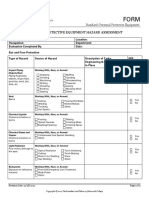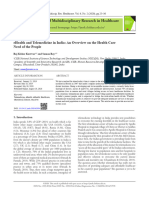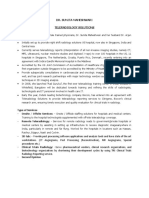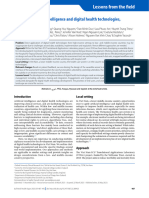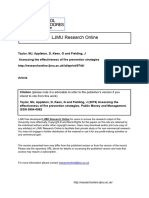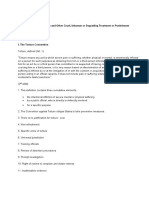Tele Medicine
Tele Medicine
Uploaded by
Pradip GuptaCopyright:
Available Formats
Tele Medicine
Tele Medicine
Uploaded by
Pradip GuptaOriginal Description:
Copyright
Available Formats
Share this document
Did you find this document useful?
Is this content inappropriate?
Copyright:
Available Formats
Tele Medicine
Tele Medicine
Uploaded by
Pradip GuptaCopyright:
Available Formats
1st International Conference on Computer
&
Information Engineering, 26-27 November, 2015
Organizer. Dept. of CSE, Rajshahi University of Engineering
&
Technology, Rajshahi, Bangladesh
Telemedicine in South Asia for Rural People:
Current Scenario and Future Recommendations
Uzzal Kumar Prodhan
Muhammad Zahidur Rahman, Israt Jahan
Computer Science & Engineering Department
Jatiya Kabi Kazi Nazrul Islam University
Trishal, Maymensingh, Bangladesh
uzzal_bagerhat@yahoo.com
Abstract
Telemedicine
encompasses
methods
Computer Science & Engineering Department
Jahangirnagar University
Savar, Dhaka, Bangladesh
for
III.
electronically transmitting medical information to sustain and/or
improve patient's health condition by using information and
The country based different telemedicine models of South
Asia are following:
communication technology. Different countries of South Asia
have tried to introduce telemedicine services from different
perspectives for the rural people where health care facilities are
A.
poor through its private and public partnership. This paper
out the potentials difficulties faced by different models and
presents the factors which should be assessed carefully for the
successful implementation of telemedicine which will be feasible,
1) Model-I: Center for Rehabilitation of Paralyzed in
Savar established telemedicine link with the Royal Navy
Hospital, Haslar, UK in 1999. This model used digital camera
and satellite telephone for consultation [1,2].
easily maintainable, sustainable and cost effective solution for the
poor people of rural areas of South Asia regions.
Keywords-telemedicine; times; dicot; dit; isro; trel
2) Model-2: TRCL demonstrated telemedicine system
in the US Trade Show 200 I in Dhaka using Icare software and
normal internet connection & started test-run of the system
between US and Bangladeshi physicians [1, 2].
INTRODUCTION
Telemedicine is a process to provide health care to the
remote areas where there is a scarcity of basic health facilities.
The main objective of telemedicine is to provide equal access
of medical expertise. It is applicable where medical experts
are rare, distances are a major factor and infrastructure is very
limited. Most of the experienced doctors and other medical
expertise are on urban based than rural areas of South Asia.
About 75 to 80% people live in rural areas in South Asia
where there are limited medical facilities are available [1]. In
order to take proper medical care, all the patients from rural
areas will have to travel to major cities where expertise
doctors are available to get medical treatment with all the
modern facilities. In this paper different telemedicine models
of South Asian countries are analyzed through literature
review and some recommendations are given for a standard
telemedicine model which will be feasible and ideal solution
for the rural people in this region.
II.
3) Model-3: Sustainable Development Network
Program (SDNP) Bangladesh started in January 2003 which
has four regional nodes in different parts of Bangladesh. These
nodes are connected to satellite by VSAT technology. Their
sessions provide consultancy and diagnostic support to the
physician at the remote end through medical experts at the
SDNP head office [3].
4) Model-4: Bangladesh University of Engineering &
Technology (BUET) and Comfort Nursing Home had started a
telemedicine project with the financial collaboration from
European Union (EU) in 2003 through e-mail. Recently the
project is not functional [1, 2].
5) Model-5: Bangladesh DNS diagnoses Centre,
Gulshan-1 and Comfort Diagnoses & Nursing Home's started
a telemedicine centre in 2004. The project was discontinued
because of lack of financial viability, patient disinterest and
poor market promotion [1, 2].
MATERILS AND METHODS
In order to carry this research, the different telemedicine
models of South Asia are collected from the renowned
journals, books and conference papers. We have analyzed
these telemedicine models and the characteristics of these
models are shown in the result section. The discussion section
summarizes the research work and lists the proposed
recommendations for standard telemedicine in the region of
South Asia.
6) Model-6: Telemedicine model established between
Diabetic Association of Bangladesh (DAB), Dhaka and
Faridpur General Hospital to access the specialist doctors in
2005 through video conferencing. The cost per consultation
was 600 taka and 20 patients per day was the target of the
project [4].
42
978-1-4673-8343-1/15/$31.00
2015
IEEE
Telemedicine Models in Bangladesh
In Bangladesh, the telemedicine project was started as a
model for the health care facilities of the rural people in 1999
[2].
examines different telemedicine models of South Asia and finds
I.
RESULTS
7) Model-7: Indian hospitals and Medinova hospital
initiated telemedicine services through e-mail and Internet in
2006 [ I ].
hospitals for Telemedicine. Rajasthan and Karnataka State
Government in collaboration with ISRO, has established
Telemedicine network for its rural people. Andhra Pradesh
and Gujarat carry out telemedicine through "104 services".
Punjab and Himachal Pradesh government connected with
Indira Gandhi Medical College, Shimla and Postgraduate
Institute of Medical Education & Research Chandigarh
through ISDN link [10].
8) Model-8: Telemedicine Service "HealthLine Dial
789" which provides different types of medical information
facility, emergency service (SMS based LAB report,
ambulance) and real time medical consultation over mobile
phone by Telemedicine Reference Centre Ltd. and Grameen
phone [5].
5) Model-5: Sanjay Gandhi Postgraduate Institute of
Medical Sciences (SGPGIMS), Lucknow model was started in
1999 in project mode [10]. SGPGI Telemedicine network has
linked 27 national and international nodes and has been
carrying out tele-education and tele-healthcare activities.
9) Model-9: Access to Information project started
between Union Information and Service Centers (UISCs) used
computer, printer, digital camera, scanner, internet, modem
and Skype from 2010. Doctors sitting at the MIS office are
giving medical consultation every working day of 4,536
unions of Bangladesh [6].
6) Model-6: SAARC Telemedicine Network was started in
April 2007. The pilot project connects one or two hospitals in
each of the SAARC countries with three to four super
specialty hospitals in India [10]. This is being developed as an
exemplary model for implementing projects at the regional
level.
10) Model-IO: Two specialized hospitals (Bangabandhu
Sheikh Mujib Medical University and National Institute of
Cardiovascular Diseases), 3 district hospitals (Shatkhira,
Nilphamari and Gopalganj) and 3 sub-district hospitals
(Pirgonj, Dakope and Debhata) used web-camera, Skype or
any other video conferencing platform where patients from
district and sub-district can get treatment from specialized
hospital [6].
7) Model-7: The Ministry of External Affairs is
implementing Pan-African e network project through
Telecommunications Consultants India Ltd. (TCIL) to
establish a VSAT-based telemedicine and tele-education
infrastructure for African countries in 53 nations of the
African Union which provides effective tele-education,
telemedicine, Internet, videoconferencing and VoIP services
[10].
II) Model-II: In 2012 ICT Ministry & Grameen Phone
implemented telemedicine between TWGBD, Aysha
Memorial Specialized Hospital, Dusthya Sathya Kendro and
Concern Worldwide for Jessore District. This project used
Telemedicine Information, Management and Education
System (TIMES), Digital Imaging and Communication in
Telemedicine (DlCOT), Stethoscope, Sphygmomanometer,
Scanner of ECG and X-ray [7].
8) Model-8: Narayana Hrudayalaya' s (NH) Telemedicine
Service it covers 332 hospitals -299 remote/rural/district
hospitals/health centers connected to 33 specialty hospitals
located in major cities through the ISRO network,. ECG
reports, AudiolVisual data, CT scans, X-rays, MRIs and their
analysis are exchanged via the telephone line, broadband
connection or satellite provided by ISRO [10].
B. Telemedicine Models in India
Telemedicine activities were started at 1999 in India [8].
9) Model-9: Apollo Hospitals Telemedicine project has
150 telemedicine centers in India and abroad [11]. The Apollo
Project has opened remote telemedicine centers that link
villagers via satellite to specialist services. Apollo's Aragonda
project was India' s first rural telemedicine station. Today, the
Apollo project has expanded with telemedicine centers at
Bangladesh and multiple sites in India.
1) Model-I: Indian Space Research Organization (ISRO)
is operating telemedicine nodes under GRAMSAT (rural
satellite) program. It has established a Telemedicine network
consisting of 382 Hospitals (51 hospital is Specialists & 306
or more is district or rural level hospital) [9, 10]. It used
satellite based connectivity among the nodes.
2) Model-2: Department of Information Technology (DIT),
Ministry of Communication and IT (MCIT), Government of
India has established more than 75 nodes all over India.
Project used ISDN, WAN & Satellite connectivity for
connecting nodes [9]. It is used for diagnosis & monitoring of
tropical diseases in West Bengal.
C.
Telemedicine Models in Sri Lanka
In Sri Lanka, the telemedicine project was started in 2003.
I) Model-I: Telemedicine activity in the country was
started in November 2003 [12]. Initially it was started in 8
hospitals over 5 districts in the country. This is a low cost,
store and forward distributed telemedicine system. Sri Lanka
Health Telematics (SRLHT) is increased with Voice over
Internet Protocol (VoIP) for real time communication during
tele-consultation sessions.
3) Model-3 : Ministry of Health and Family Welfare (MoH
FW) was implemented by integrated Disease Surveillance
Programme network with the help of ISRO. OncoNET India is
a network connecting 25 Regional Cancer Centers and 100
peripheral centers to provide comprehensive cancer treatment
facilities and carry out cancer prevention and research
activities [9].
&
2) Model-2: The Telemedicine Consultation Centre in
Colombo and Apollo Hospitals in India started telemedicine
through health-care information technology in 2011 [11]. It
offered medical consultation service for rural patients who
4) Model-4: State Governments of Orissa and Uttar
Pradesh, Chhattisgarh and Kerala Oncology Network connect
its secondary level hospitals to medical colleges and specialty
43
4) Model-4: Multitasking of e-Health training center HFH
was started in 2008.Virtual training lab at HFH provided
distant training to nurses & other medical personal from HFH
to the RS. This model offers also advanced training, healthcare
and rehabilitation facilities [16].
were seeking consultation with Apollo hospitals in India.
Medical information of patients including high definition
images of medical reports of X-rays scans and ECGs were
stored at a data centre in Hyderabad.
D.
Telemedicine Models in Nepal
5) Model-5: Aga Khan Health Services started in 20072013 [16]. Infrastructure used in this project was Gigabit
Ethernet at AKUH Karachi and 2Mbps link with Kabul.
1) Model-I: Telemedicine program is a newly
implemented by the Government of Nepal and it is named as
'rural-telemedicine program' [13]. The rural-telemedicine
program was initially implemented in 25 district hospitals of
hilly and mountainous districts. In the year 2012, government
further extended the program in 5 more districts hospitals so in
the present context the Telemedicine program is implemented
in total 30 districts out of 75 districts of the country. Rural
telemedicine program is using store and forward method,
video-conferencing and telephone based consultation.
E.
6) Model-6: Jaroka Tele health care started in 2006. The
technology used in this project is EDGE mobile internet and
VSAT server connection. Store and forward method is used in
this project [16].
IV.
From this study it was found that most of the people of
South Asia are living in rural areas and only 15 to 20% people
live in urban areas where health facilities are sufficient and
moderated. Most of the rural peoples will have to travel to
urban areas for their basic treatment. In this respect,
telemedicine can play a vital role for the delivery of healthcare
services to the huge number of people of rural areas.
Telemedicine Models in Bhutan
1) Model-I: The main objectives of the Rural
Telemedicine Project in Bhutan are to provide a forum for the
doctors at the remote districts to tele-consult cases to the
specialists at the national referral hospital [14]. This project
was implemented in April 2009 in 14 rural sites with supply of
the following equipments: Laptops, Non-invasive vital sign
Monitor, Portable ECG Machines and Compatible software to
interface the equipment.
F.
In order to find the cost benefit analysis of telemedicine,
study shows that telemedicine models like Grameen phone
telephone medical advice fees are 15 Taka (around US$0.20)
for a three-minute call to a qualified physician, AMCARE
membership fees were US$0.60-US$20 per month, Aponjon
registered members pay 5 Taka per message, Telemedicine
established between DAB and Faridpur need 600 taka per
consultation. The cost should be low so that poor people can
avail the cost easily.
Telemedicine Models in Maldives
1) Model-I: In 2002 the first Telemedicine project was
developed by the government as the 'Health Telematics
Project' funded by World Health Organization [15].
2) Model-2: In the year 2004 Telemedicine 2nd project (a
component of Integrated Human Development Project
(IHDP)) was started and funded by World Bank. Poor project
management, improper risk assessment and human factors that
contributed to failure of the past telemedicine projects.
G.
DISCUSSION
From the study of different telemedicine models in South
Asia, it was found that the expectation of rural people is to
access the medical care from the expert doctors with low cost
as the expert doctors are not available in rural areas. The rural
people will be satisfied if they can get health care services
through Telemedicine without going to the urban area. This
will save their money, travel difficulties and mental happiness.
Telemedicine Models in Pakistan
The Prominent Telemedicine Projects of Pakistan were
started from 1998 [16].
The similarities of different models of South Asian
countries are most of the countries used store and forward
method at the early stages of telemedicine, primary aim of the
projects are to enhance the healthcare facilities, most of the
models are project basis. The common dissimilarities are the
used technology in the models.
1) Model-I: The telemedicine model Telemedpak started
in 1998. The area of the project was Resource Center RC
Holy Family Hospital HFH Rawalpindi and Remote Station
RS- Taxila, Gilgit. Infrastructure used in this model is dial up
modem internet connection. This model used Store and
Forward method [17].
The significant contributions of this paper are to review
most of the widely used telemedicine models and recommend
the attributes of the proposed telemedicine model which will
be feasible, easily maintainable and cost effective solution for
the poor rural people of South Asian regions.
2) Model-2:The model COMSATS started in 2002 &
2005. The area of the project was RC- Comsats Islamabad and
RS - Gujar Khan & Gilgit. Infrastructure used in this project
was Internet via landline / VSAT (dial up). It used store and
forward method [17].
In order to deliver proper medical facilities to the poor
people of South Asian countries, the following
recommendation can play a vital role for the effective
telemedicine of these countries:
3) Model-3: The project Health Net Suparco & MolT
started in 2007-2010 [16]. Infrastructure used Paksat-l
satellite 500 Kbps Up/Down link connection. This model
facilitates tteleconferencing facility.
44
Selecting the right model: From our analysis we have
found that there are different telemedicine models in
different countries by which patients are being served
but there is no standard model by which all the models
can be merged. However it is necessary to develop a
viable telemedicine model so that any remote patient
can avail better service.
Choosing telemedicine network and non interruptible
service: Telemedicine models used VSAT, Satellite,
Optical Fiber, Broadband, Wireless and different
connectivity style. Different network has some specific
advantages and others have disadvantages for which
models are failed to meet the requirements of the
smooth consultation. So we have to choose the proper
network connectivity for implementation of standard
model and the smooth continuation of the consultation
should be ensured.
Financial support and cost effectiveness: The financial
investment for the establishment of telemedicine and
remote user payment should be low so that it can be
used widely.
User satisfaction: Telemedicine models which are to be
implemented need to satisfy their user's requirements.
To attract rural population, payment for the servIce
should be lower than the urban counterpart.
Proper training: As telemedicine services are given
between two geographically separated areas so there
needs to give proper training facilities to rural people
and specialized persons so that both parties can
actively participate in the consultation. As a result, the
goals of telemedicine can be fulfilled.
Security of data: Telemedicine data are moved through
the network, there is possibility to leakage of personal
data of patients. Special security of data should be
made on the collected data so that everybody can trust
on the system.
Setup standard equipments for automation: Standard
compatible telemedicine equipments need to be setup
in both ends so that vital different signs of patients can
be measured electronically. All the collected data of
patients should be stored in the central server of the
telemedicine for future use and processed data digitally
to give the service to the patients.
V.
CONCLUSION
Recently, telemedicine is playing a vital role in order to
develop the health care facilities for the developing countries
of South Asia. Through this process, the different telemedicine
models are offering various services with a low cost for rural
people of South Asia. Therefore, a standard telemedicine
infrastructure is essential in order to provide the health care
facilities for the rural people of South Asia. We believe that
the proposed telemedicine system based on our
recommendations can play a vital role in order to get medical
health care facilities with a cost effective way for the rural
people of South Asian countries.
ACKNOWLEDEGEMENT
The authors would like to express sincere gratitude to the
Ministry of Information & Communication Technology,
Bangladesh for their financial support.
REFERENCES
[1]
M. Sanaullah Chowdhury, Md. Humayun Kabir, Kazi Ashrafuzzaman
and Kyung-Sup Kwak "A telecommunication network architecture for
telemedicine in Bangladesh and its applicability," International Journal
of Digital Contents Technology and its Applications, vol. 3, no. 3,
September 2009.
[2]
Ahsannun Nessa, Moshaddique AI Ameen, Sana Ullah and Kyung
Kwak "Applicability of telemedicine in Bangladesh: current status and
future prospects," International Arab Journal of Information
Technology,vol. 7,no. 2,Page 138-145,April 2010.
[3]
Murelli, E., Arvanitis and Theodoros "E-health & learning: The
Bangladesh experience," Technology and Health Care, vol.II, issue 5,
pp.341-344,2003.
[4]
Vassallo D., Hoque F., Roberts M., Patterson V., Swinfen P., and
Swinfen R., "An evaluation of the first year's experience with a low cost
telemedicine link in Bangladesh," Computer Journal of Telemedicine
and Telecare,vol. 7,no. 3,pp. 125,138,2001.
[5]
Md. Mahfuz Ashrafi, Noushin Laila Ansari, Bushra Tahseen Malik and
Barnaly Rashid. (2011). Evaluating the impact of mobile phone based
'health help line' service in rural Bangladesh [online]. Available FTP:
http://www.brainstorm-d.com/secured/publications
[6]
DGHS, Bangladesh. Telemedicine Services [online]. Available FTP:
http://www.dghs.gov.bd/index.php/en/e-health/our-ehealth-eservices/84english-rootlehealth-eservice/490-telemedicine-service
Abdullah Mamun.(2013). GP launches Telemedicine services in Jessore
[Online]. Available FTP: http://archive.thedailystar.netlbeta2/news/gp
launches-telemedicine-service-in-jessore/
[7]
[8]
Debjit Bhowmik, S.Duraivel, Rajnish Kumar Singh and K.P.Sampath
Kumar "Telemedicine- an innovating healthcare system in India," The
Pharma Innovation Journal,vol. 2,no.4,2013.
[9]
Mishra, S.K., Basnet, R. and Singh, K. "Current telemedicine
infrastructure, network, applications in India," 81h IEEE International
Conference on e-health networking, application and services, pp.46-49,
2006.
[10] Saroj Kanta Mishra, Indra Pratap Singh and Repu Daman Chand
"Current status of telemedicine network in India
and future
perspective," The proceedings of the Asia-Pacific Advanced Network,
vo. 32,pp. 151-163,2012.
[II] Krishnan Ganapathy and Aditi Ravindra 'Telemedicine in India: The
Apollo
story:
Apollo
telemedicine
networking
foundation,"
Telemedicine and e-health,vol. 15,no. 6,july/august 2009.
[12] R. B. Marasinghe "Telehealth - bringing healthcare to one's doorstep:
how ready is Sri Lanka?," Sri Lanka Journal of Bio-Medical
Informatics,voU,no.3,pp. 124-38,2010.
[13] Ramesh R. Subedi, Carrie B. Peterson and Sofoklis Kyriazakos
'Telemedicine for rural and underserved communities of Nepal," 15th
Nordic-Baltic Conference on Biomedical Engineering and Medical
Physics,IFMBE Proceedings vol. 34,pp. 117-120,2011.
[14] Zhao Y, Nakajima I, and Jujoji H, "Onsite investigation of the early
phase of Bhutan health telemetric project," J Med Syst,pp. 67-77,2002.
[15] Mariyam Nazviya and Subrahmanyam Kodukula "Evaluation of critical
success factors for telemedicine implementation," International Journal
of Computer Applications,vol. 12,no.I0,January 20II.
[16] Khawaja, Wasim Shahid,and Lu Xinhai " A case study of telemedicine
for disaster management in underdeveloped remote districts of
Balochistan, Pakistan," Journal of Economics and Sustainable
Development,vol. 4,no. 20,2013.
[17] Niamat Ullah, Pervez Khan, Najnin Sultana and Kyung Sup kwak "A
telemedicine network model for health applications in Pakistan: current
status and future prospects," Journal of Digital Content Technology and
its Applications,vol. 3,no. 3,September 2009.
45
You might also like
- NURS InformDocument36 pagesNURS Informmeb0% (1)
- Chemistry PAG 11.1 Teacher v2.0Document10 pagesChemistry PAG 11.1 Teacher v2.0CostaCo100% (2)
- Cse327 Project ReportDocument30 pagesCse327 Project ReportMd. Rashedul Islam 1511108042No ratings yet
- Personal Protective Equipment Hazard AssessmentDocument5 pagesPersonal Protective Equipment Hazard AssessmentKrsnaPentayah100% (1)
- Ansi C37 32 1996Document42 pagesAnsi C37 32 1996dwas1314No ratings yet
- Telemedicine Division, Mohfw, Govt. of IndiaDocument10 pagesTelemedicine Division, Mohfw, Govt. of IndiaOm Prakash PadhiNo ratings yet
- India Ehealth StatusDocument34 pagesIndia Ehealth StatusMukesh M. BhoiNo ratings yet
- Virtual Clinic: A Telemedicine Proposal For Remote Areas of PakistanDocument6 pagesVirtual Clinic: A Telemedicine Proposal For Remote Areas of PakistanONAFUWA AyodeleNo ratings yet
- Paper 30Document6 pagesPaper 30kaustubh manchekarNo ratings yet
- Telemedicine in IndiaDocument21 pagesTelemedicine in IndiaPritam RoyNo ratings yet
- Role of Digital Image Processing in Telemedicine PDFDocument3 pagesRole of Digital Image Processing in Telemedicine PDFSimion IulianNo ratings yet
- Drrstyagi: DR R S Tyagi'S OverviewDocument6 pagesDrrstyagi: DR R S Tyagi'S OverviewKuldip SinghNo ratings yet
- Use of ICT As Advance Teaching Technology in IndiaDocument7 pagesUse of ICT As Advance Teaching Technology in IndiarewantNo ratings yet
- Neural Network Models Selection Scheme For Health Mobile App DevelopmentDocument13 pagesNeural Network Models Selection Scheme For Health Mobile App DevelopmentIAES IJAINo ratings yet
- GR 6 ReportDocument6 pagesGR 6 ReportShubham ThoratNo ratings yet
- Apollo Case Study - 0 PDFDocument18 pagesApollo Case Study - 0 PDFVisweswar AnimelaNo ratings yet
- Project ProposalDocument15 pagesProject ProposalDhananjay ChaudharyNo ratings yet
- Pan Network August 2011Document2 pagesPan Network August 2011Aaditya Rakesh BansalNo ratings yet
- E-Health Initiatives in IndiaDocument38 pagesE-Health Initiatives in IndiaAnjali GuptaNo ratings yet
- Telemedicine JourneyDocument48 pagesTelemedicine JourneySudip ShakyaNo ratings yet
- A Telemedicine Platform: A Case Study of Apollo Hospitals Telemedicine ProjectDocument25 pagesA Telemedicine Platform: A Case Study of Apollo Hospitals Telemedicine Projecttanushree26No ratings yet
- GNED 06 Chapter 8Document61 pagesGNED 06 Chapter 8Renato KelisteNo ratings yet
- A telemedicine platform- a case study of ApolloDocument18 pagesA telemedicine platform- a case study of ApolloRaj Kiran SyamNo ratings yet
- 1000045200_01Document288 pages1000045200_01karikala cholanNo ratings yet
- Pdf&rendition 1 1Document15 pagesPdf&rendition 1 1Monika AlecNo ratings yet
- Java Micro-ProjectDocument22 pagesJava Micro-Projectkarpearyan939No ratings yet
- Telemedicine: Cellular Operators Association of IndiaDocument24 pagesTelemedicine: Cellular Operators Association of IndiahanumanthgowdaNo ratings yet
- Research Project Seba (AutoRecovered) .EditedDocument52 pagesResearch Project Seba (AutoRecovered) .EditedHycinthNo ratings yet
- Matecconf Icmed2024 01125Document8 pagesMatecconf Icmed2024 01125Sharath M NNo ratings yet
- Science & Technology Short NotesDocument9 pagesScience & Technology Short NotesPranoy KumarNo ratings yet
- eHealth_and_Telemedicine_in_India_An_Overview_on_tDocument12 pageseHealth_and_Telemedicine_in_India_An_Overview_on_tNehaNo ratings yet
- Mobile Application For Monitoring and Management of Out PatientsDocument7 pagesMobile Application For Monitoring and Management of Out PatientsMegan RevitaNo ratings yet
- Telephones and The Provision of Community Based Mental Health Services in The Northwest and Southwest Regions of CameroonDocument14 pagesTelephones and The Provision of Community Based Mental Health Services in The Northwest and Southwest Regions of CameroonEditor IJTSRDNo ratings yet
- Telemedicine in Rural IndiaDocument3 pagesTelemedicine in Rural IndiaakshaykgodaraNo ratings yet
- Ijaiem 2014 02 26 054Document6 pagesIjaiem 2014 02 26 054International Journal of Application or Innovation in Engineering & ManagementNo ratings yet
- Ip Based Network For Ehealth Applications: Practical Cases in Developing CountriesDocument40 pagesIp Based Network For Ehealth Applications: Practical Cases in Developing CountriesahamidianNo ratings yet
- NTADBM - Group 3 Project ReportDocument16 pagesNTADBM - Group 3 Project ReportntadbmNo ratings yet
- Teleradiology SolutionsDocument1 pageTeleradiology SolutionsDairy FarmNo ratings yet
- Impact and Utilization of Wireless Sensor Network in Rural Area For Health CareDocument6 pagesImpact and Utilization of Wireless Sensor Network in Rural Area For Health Careeditor_ijarcsseNo ratings yet
- 1 s2.0 S2405844020300190 MainDocument9 pages1 s2.0 S2405844020300190 MainAlex KwokNo ratings yet
- Telemedicine & Education Centre in Four Tribal Settlements in Karulayi, Nilambur As Sansad Adarsh Gram Yojana ProjectDocument10 pagesTelemedicine & Education Centre in Four Tribal Settlements in Karulayi, Nilambur As Sansad Adarsh Gram Yojana ProjectAbhilash ChambanNo ratings yet
- Cloud-Powered Platform For Medical Representatives To Boost Prescription RatesDocument16 pagesCloud-Powered Platform For Medical Representatives To Boost Prescription Ratesgamerboy18teenNo ratings yet
- COIL_Aljibe_SHTI-310-SHTI230923Document5 pagesCOIL_Aljibe_SHTI-310-SHTI230923Alvin MarceloNo ratings yet
- Communication and Training For Healthcare WorkersDocument3 pagesCommunication and Training For Healthcare WorkersPriyaNo ratings yet
- E-Health in Bangladesh: Current Status, Challenges, and Future DirectionDocument11 pagesE-Health in Bangladesh: Current Status, Challenges, and Future DirectionThe Greater ChungusNo ratings yet
- Ñôp Ñ ÑPP ÑÑ Ñôññôp Ñ Pô ÑDocument73 pagesÑôp Ñ ÑPP ÑÑ Ñôññôp Ñ Pô ÑChahat NarulaNo ratings yet
- Imteaj 2016Document7 pagesImteaj 2016Sameer Singh 1135No ratings yet
- Adaptation and Use of Telemedicine in Saudi ArabiaDocument4 pagesAdaptation and Use of Telemedicine in Saudi ArabiaGreat SingerNo ratings yet
- Fin Irjmets1705419474Document13 pagesFin Irjmets1705419474minatonamikaze2752No ratings yet
- TelemedicineDocument8 pagesTelemedicineBarnita Sharma100% (1)
- Articulo 6Document6 pagesArticulo 6JULISSA MARIN VASQUEZNo ratings yet
- EHealth MalaysiaDocument18 pagesEHealth MalaysiaCW LyeNo ratings yet
- MalaysianDocument3 pagesMalaysianMuhammad Haikal SatriaNo ratings yet
- IGRID Smart Grid Capacity Development and Enhancement in Tanzania by Mvungi and HannuDocument94 pagesIGRID Smart Grid Capacity Development and Enhancement in Tanzania by Mvungi and HannuMwanamarundiNo ratings yet
- Telecommunication Sector in Himachal Pradesh Submitted by Yugal KishorDocument146 pagesTelecommunication Sector in Himachal Pradesh Submitted by Yugal KishoritsankurzNo ratings yet
- Determinants of Customer Satisfaction Towards Broadband Services in MalaysiaDocument12 pagesDeterminants of Customer Satisfaction Towards Broadband Services in MalaysiaCecille GuillermoNo ratings yet
- BCI_ISDA1Document12 pagesBCI_ISDA1Tekeshwar kumarNo ratings yet
- Child Health Tracking Using ML - AbstractDocument4 pagesChild Health Tracking Using ML - Abstractgopidass392No ratings yet
- EJMCM - Volume 7 - Issue 3 - Pages 525-530Document6 pagesEJMCM - Volume 7 - Issue 3 - Pages 525-530Bhoomi SarnaNo ratings yet
- 2020-Current Challenges of Digital Health Interventions in Pakistab-mixed Methods AnalysisDocument14 pages2020-Current Challenges of Digital Health Interventions in Pakistab-mixed Methods AnalysisSabrina NMNo ratings yet
- TelemedicineDocument6 pagesTelemedicineMarcNo ratings yet
- Adoption of Health Information SystemsDocument9 pagesAdoption of Health Information SystemsFitriani FitrianiNo ratings yet
- Fig. 1 Airfoil Model Mounted in Bending and Torsional SpringsDocument4 pagesFig. 1 Airfoil Model Mounted in Bending and Torsional SpringsPradip GuptaNo ratings yet
- AI Skills Taxonomy JuneDocument6 pagesAI Skills Taxonomy JunePradip GuptaNo ratings yet
- WX CX CX CXC: DW EI X H DXDocument6 pagesWX CX CX CXC: DW EI X H DXPradip GuptaNo ratings yet
- Isit437 L01Document8 pagesIsit437 L01Pradip GuptaNo ratings yet
- Approximate Methods: Module: 15 Lecture: 1Document7 pagesApproximate Methods: Module: 15 Lecture: 1Pradip GuptaNo ratings yet
- Total DerivativeDocument8 pagesTotal DerivativePradip GuptaNo ratings yet
- m14l31 PDFDocument7 pagesm14l31 PDFPradip GuptaNo ratings yet
- WX CX CX CXC: DW EI X H DXDocument6 pagesWX CX CX CXC: DW EI X H DXPradip GuptaNo ratings yet
- Fig. 1 Airfoil Model Mounted in Bending and Torsional SpringsDocument4 pagesFig. 1 Airfoil Model Mounted in Bending and Torsional SpringsPradip GuptaNo ratings yet
- Module: 12 Lecture: 1: MX MX CX CX KX KX FT MX MX CX CX KX KX FTDocument4 pagesModule: 12 Lecture: 1: MX MX CX CX KX KX FT MX MX CX CX KX KX FTPradip GuptaNo ratings yet
- m15l38 PDFDocument3 pagesm15l38 PDFPradip GuptaNo ratings yet
- m16l41 PDFDocument4 pagesm16l41 PDFPradip GuptaNo ratings yet
- Approximate Methods: Module: 15 Lecture: 1Document7 pagesApproximate Methods: Module: 15 Lecture: 1Pradip GuptaNo ratings yet
- m11l23 PDFDocument7 pagesm11l23 PDFPradip GuptaNo ratings yet
- Module: 13 Lecture: 3: Rigid Body ModeDocument4 pagesModule: 13 Lecture: 3: Rigid Body ModePradip GuptaNo ratings yet
- Laplace Transformation: T F KX X C X MDocument3 pagesLaplace Transformation: T F KX X C X MPradip GuptaNo ratings yet
- With Viscous Damping (Under Damped)Document6 pagesWith Viscous Damping (Under Damped)Pradip GuptaNo ratings yet
- Beat Phenomenon: O, RespectivelyDocument5 pagesBeat Phenomenon: O, RespectivelyPradip GuptaNo ratings yet
- System With Two DOF: Free Undamped VibrationDocument4 pagesSystem With Two DOF: Free Undamped VibrationPradip GuptaNo ratings yet
- Vibration Absorber:: M and K Is The Original SDOF System and The Absorber Consists M and The Spring KDocument2 pagesVibration Absorber:: M and K Is The Original SDOF System and The Absorber Consists M and The Spring KPradip GuptaNo ratings yet
- m7l13 PDFDocument10 pagesm7l13 PDFPradip GuptaNo ratings yet
- AWS Learning PathDocument1 pageAWS Learning PathNoman AliNo ratings yet
- GULBAI TEKRA SITE ANALYSIS Roll No 17 PDFDocument1 pageGULBAI TEKRA SITE ANALYSIS Roll No 17 PDFAyesha roosminNo ratings yet
- MATH1216 Practice 3567Document16 pagesMATH1216 Practice 3567JanggutNo ratings yet
- Rle Ncm106 Abg InterpretationDocument12 pagesRle Ncm106 Abg InterpretationEggy PascualNo ratings yet
- Topic 5 - A Proposed Urban Revitalization of P. Burgos St. Poblacion Batangas CityDocument5 pagesTopic 5 - A Proposed Urban Revitalization of P. Burgos St. Poblacion Batangas CityKat Alea UmaliNo ratings yet
- WS - X, Chem Metals Non-Metals 2019-20.pdf 20240824 153720 0000Document2 pagesWS - X, Chem Metals Non-Metals 2019-20.pdf 20240824 153720 0000masterfaiheng7No ratings yet
- Control of NOx and Other Emissions in Micro Gas Turbine CombustorsDocument11 pagesControl of NOx and Other Emissions in Micro Gas Turbine CombustorsSameer V KulkarniNo ratings yet
- 10 Case StudiesDocument6 pages10 Case StudiesRajjnishNo ratings yet
- Structural and Building Materials: Prepared By: Christine Joy L. Ocon Ernesto M. Padilla JRDocument15 pagesStructural and Building Materials: Prepared By: Christine Joy L. Ocon Ernesto M. Padilla JRAliah Mae SémbläntêNo ratings yet
- Assessing The Effectiveness of Fire Prevention StrategiesDocument19 pagesAssessing The Effectiveness of Fire Prevention Strategiesvishvajeetsinh003No ratings yet
- Washing Machine: User ManualDocument24 pagesWashing Machine: User ManualMyo Kyaw SwarNo ratings yet
- Bibliography 1Document8 pagesBibliography 1Cyril Jane Caanyagan AcutNo ratings yet
- 02 - CB Tut (B1-5 Ans)Document5 pages02 - CB Tut (B1-5 Ans)2022 BALAKRISHNAN ADHITHINo ratings yet
- Theses Undergrad ByaccessionDocument77 pagesTheses Undergrad ByaccessionPAANONo ratings yet
- Principles of Electro Mechanical Energy ConversionDocument30 pagesPrinciples of Electro Mechanical Energy ConversionAarushi PublicationsNo ratings yet
- NotesDocument3 pagesNotesKarthick MurugamoorthiNo ratings yet
- POWERPOINT On Convention Against TortureDocument2 pagesPOWERPOINT On Convention Against Torturekemsue1224No ratings yet
- Unit 15 Balneotherapy: 1. Warm-UpDocument8 pagesUnit 15 Balneotherapy: 1. Warm-UpJovan MitrevskiNo ratings yet
- Combine Rope I and II 1 Task Book All in ONe 10-19-12Document38 pagesCombine Rope I and II 1 Task Book All in ONe 10-19-12f.BNo ratings yet
- Operators ManualDocument68 pagesOperators ManualHarry WNo ratings yet
- The Influence of Workplace Environment On Workers' Welfare, Performance and Productivity Emmanuel Majekodunmi Ajala University of IbadanDocument9 pagesThe Influence of Workplace Environment On Workers' Welfare, Performance and Productivity Emmanuel Majekodunmi Ajala University of IbadanKhalis AdamNo ratings yet
- Book Chapter IV Halal Pharmacy IndustryDocument12 pagesBook Chapter IV Halal Pharmacy IndustryMitra AmeliaNo ratings yet
- Class Mammalia NotesDocument17 pagesClass Mammalia NotesSamuel TosinNo ratings yet
- Lipids (Fats and Oil)Document19 pagesLipids (Fats and Oil)liaprielaNo ratings yet
- 10th Language English 1 - RemovedDocument12 pages10th Language English 1 - RemovedKiruthika GNo ratings yet
- Estimating and Costing.1-10Document10 pagesEstimating and Costing.1-10sukritidan1990No ratings yet



